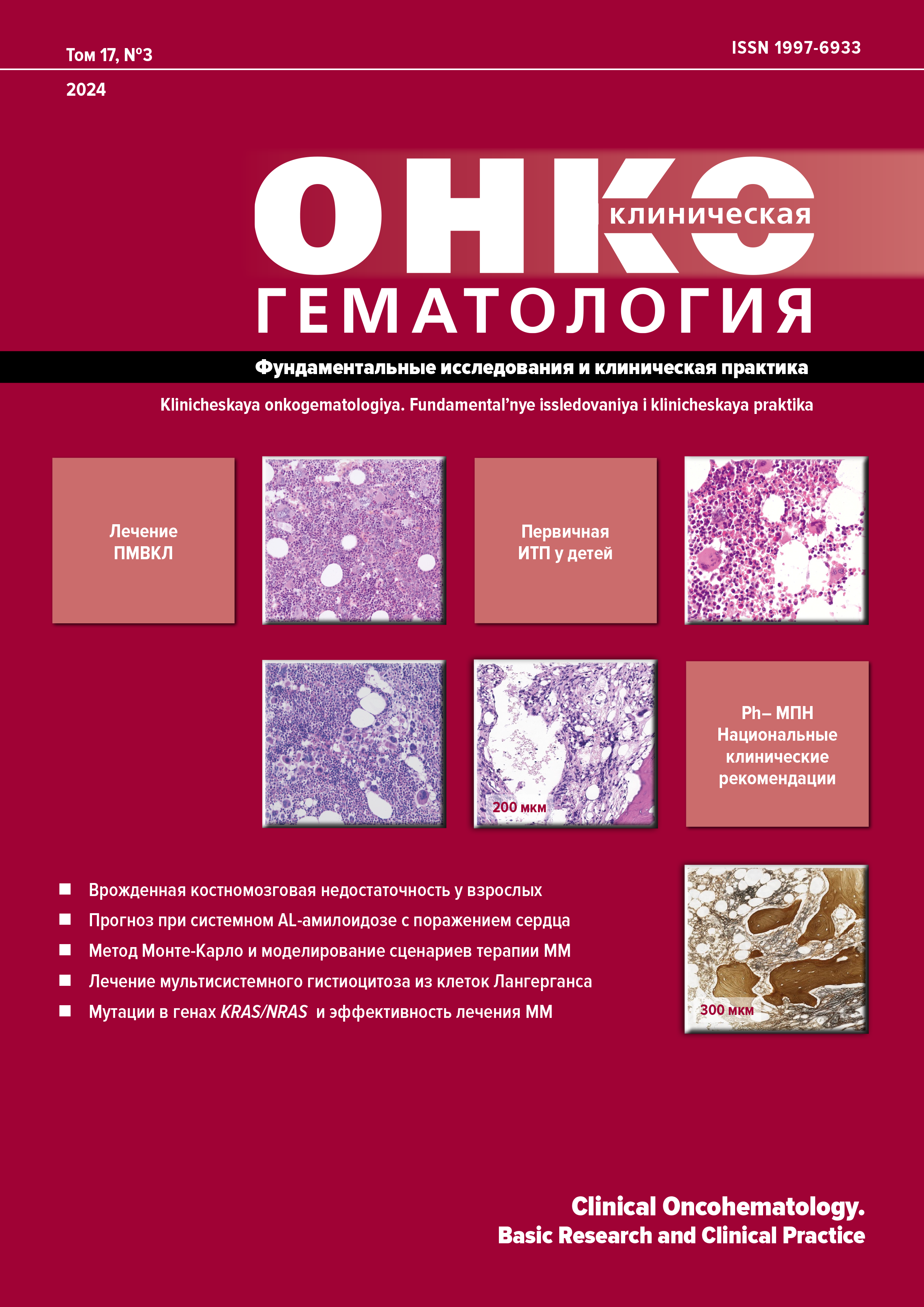Abstract
In Russia, like in the rest of the world, the number of overweight people has been growing for the last 20 years. According to different studies, obesity and overweight incidence among adults is 20.5–54.0 %. Obesity incidence increased from 10.8 % in 1993 to 27.9 % in 2017 in men and from 26.4 to 31,8 % in women, respectively. Pharmacokinetics of drugs including cytostatic agents, differs in obese vs. normal-weight patients. This is accounted for by renal/hepatic clearance changes as well as by increased distribution of lipophilic drugs with their enhanced protein-binding ability. All these factors create a challenge for a correct calculation of drug doses for obese patients. This issue becomes particularly acute when such patients undergo allogeneic hematopoietic stem cell transplantation with preconditioning regimens using sublethal drug doses. This paper attempts to review current approaches to drug dose calculation to be used in preconditioning regimens for over- and underweight patients.
References
- Алферова В.И., Мустафина С.В. Распространенность ожирения во взрослой популяции Российской Федерации (обзор литературы). Ожирение и метаболизм 2022;19(1):96–105. doi: 10.14341/omet12809. [Alferova V.I., Mustafina S.V. The prevalence of obesity in the adult population of the Russian Federation (literature review). Obesity and metabolism. 2022;19(1):96–105. doi: 10.14341/omet12809. (In Russ)]
- Krenitsky J. Adjusted body weight, pro: evidence to support the use of adjusted body weight in calculating calorie requirements. Nutr Clin Pract. 2005;20(4):468–73. doi: 10.1177/0115426505020004468.
- Gibbs JP, Gooley T, Corneau B, et al. The impact of obesity and disease on busulfan oral clearance in adults. Blood. 1999;93(12):4436–40.
- Matteucci S, De Pasquale G, Pastore M, et al. Low-bacterial diet in cancer patients: a systematic review. Nutrients. 2023;15(14):3171. doi: 10.3390/nu15143171.
- Toenges R, Greinix H, Lawitschka A, et al. Current practice in nutrition after allogeneic hematopoietic stem cell transplantation – Results from a survey among hematopoietic stem cell transplant centers. Clin Nutr. 2021 40(4):1571–7. doi: 10.1016/j.clnu.2021.02.030.
- Perkins JB, Kim J, Anasetti C, et al. Maximally tolerated busulfan systemic exposure in combination with fludarabine as conditioning before allogeneic hematopoietic cell transplantation. Biol Blood Marrow Transplant. 2012;18(7):1099–107. doi: 10.1016/j.bbmt.2011.12.584.
- Ljungman P, Hassan M, Bekassy A, et al. High busulfan concentrations are associated with increased transplant-related mortality in allogeneic bone marrow transplant patients. Bone Marrow Transplant. 1997;20:909–13. doi: 10.1038/sj.bmt.1700994.
- Salvaris R, Salman S, O’Halloran S, et al. Evaluating the efficacy, toxicity and pharmacokinetic profile of oral busulfan in allogeneic stem cell transplant patients. Blood Cell Ther. 2022;5(2):61–8. doi: 10.31547/bct-2021-019.
- Verbraecken J, van de Heyning P, De Backer W, Van Gaal L. Body surface area in normal-weight, overweight, and obese adults. A comparison study. Metabolism. 2006;55(4):515–24. doi: 10.1016/j.metabol.2005.11.004.
- Huang H, Liu Q, Zhang X, et al. External evaluation of population pharmacokinetic models of busulfan in chinese adult hematopoietic stem cell transplantation recipients. Front Pharmacol. 2022;13:835037. doi: 10.3389/fphar.2022.835037.
- Slattery JT, Sanders JE, Buckner CD, et al. Graft-rejection and toxicity following bone marrow transplantation in relation to busulfan pharmacokinetics. Bone Marrow Transplant 1995;16(1):31–42.
- Le Blanc K, Ringden O, Remberger M. A low body mass index is correlated with poor survival after allogeneic stem cell transplantation. Haematologica. 2003;88(9):1044–52.
- Palmer J, McCune JS, Perales MA, et al. Personalizing Busulfan-Based Conditioning: Considerations from the American Society for Blood and Marrow Transplantation Practice Guidelines Committee. Biol Blood Marrow Transplant. 2016;22(11):1915–25. doi: 10.1016/j.bbmt.2016.07.013.
- Bubalo J, Carpenter PA, Majhail N, et al. Conditioning chemotherapy dose adjustment in obese patients: a review and position statement by the American Society for Blood and Marrow Transplantation practice guideline committee. Biol Blood Marrow Transplant. 2014;20(5):600–16. doi: 10.1016/j.bbmt.2014.01.019.
- Andersson BS, de Lima MJ, Saliba RM, et al. Pharmacokinetic dose guidance of IV busulfan with fludarabine with allogeneic stem cell transplantation improves progression free survival in patients with AML and MDS; results of a randomized phase III study. Blood. 2011;118(21):892. doi: 10.1182/blood.V118.21.892.892.
- Griffin SP, Wheeler SE, Wiggins LE, et al. Pharmacokinetic and clinical outcomes when ideal body weight is used to dose busulfan in obese hematopoietic stem cell transplant recipients. Bone Marrow Transplant. 2019;54(2):218–25. doi: 10.1038/s41409-018-0240-3.
- Deeg HJ, Seidel K, Bruemmer B, et al. Impact of patient weight on non-relapse mortality after marrow transplantation. Bone Marrow Transplant. 1995;15(3):461–8.
- Klyuchnikov E, Langebrake C, Badbaran A, et al. Individualized busulfan dosing improves outcomes compared to fixed-dose administration in pre-transplant minimal residual disease-positive acute myeloid leukemia patients with intermediate-risk undergoing allogeneic stem cell transplantation in CR. Eur J Haematol. 2023;110(2):188–97. doi: 10.1111/ejh.13893.
- Ruutu T, van der Werf S, van Biezen A, et al. Use of busulfan in conditioning for allogeneic hematopoietic stem cell transplantation in adults: a survey by the Transplant Complications Working Party of the EBMT. Bone Marrow Transplant. 2019;54(12):2013–9. doi: 10.1038/s41409-019-0579-0.
- Clemmons AB, Evans S, DeRemer DL, Awan FT. Busulfan dosing (Q6 or Q24) with adjusted or actual body weight, does it matter? J Oncol Pharm Pract. 2015;21(6):425–32. doi: 10.1177/1078155214541571.
- Wang Y, Kato K, Le Gallo C, et al. Dosing algorithm revisit for busulfan following IV infusion. Cancer Chemother Pharmacol. 2015;75(3):505–12. doi: 10.1007/s00280-014-2660-0.

This work is licensed under a Creative Commons Attribution-NonCommercial-ShareAlike 4.0 International License.
Copyright (c) 2024 Clinical Oncohematology

